The ex-racehorse: a huge heart, a strong work ethic, great athleticism, wonderful sensitivity… and, potentially, a host of physical issues. Are you able to identify the problems so often present in these superb equine athletes?
A sports career can be tough on the body, as any committed athlete will admit. No matter how successful the athlete, the wear and tear and dings and dents will just keep on coming. It’s an inevitable consequence of making the body work at its outer limits of strength, speed and endurance: there are going to be times when the body just can’t make it or just can’t take the pressure. And that doesn’t count the spills and collisions that happen along the way. The same is as true for any top athlete as for any trainee who doesn’t make it past the foothills of success. And the same is definitely as true for racehorses as for any human Olympiad.
All text (c) Jane Clothier, https://thehorsesback.com No reproduction without permission. Thanks!
The damage carried by ex-racehorses
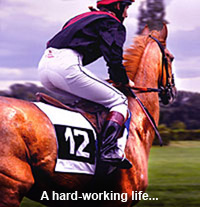 Just how much damage an ex-racehorse displays in its physique depends on several things:
Just how much damage an ex-racehorse displays in its physique depends on several things:
- the methods of training used,
- the speed with which the training was introduced and stepped up,
- the athletic qualities of that horse’s body – conformation, maturity and sheer unquantifiable athleticism,
- the treatment given and recovery time allowed for injuries at the time they occurred – assuming all were recognized (not all are visible or obvious),
- the demands placed on the horse in terms of number of races and recovery time between races,
- the length of time spent in racing, enabling the above to occur,
- the horse’s mental and emotional ability to cope with physical problems (it varies enormously).
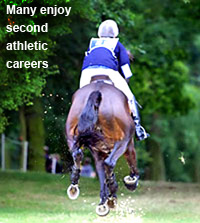 As in any sport, there are things that are done well, and things that are not done so well. Informed training and misinformed. Well judged and misjudged. Just as in the rest of the equine world.
As in any sport, there are things that are done well, and things that are not done so well. Informed training and misinformed. Well judged and misjudged. Just as in the rest of the equine world.
Some thoroughbreds come out of the racing industry in fine fettle and have splendid second athletic careers in high end competition. Many have lower level issues that come right with some rehabilitation, leaving them suited to successful but less demanding careers. Others may be more suited to recreational homes, where life is one long pleasurable trail ride.
Unfortunately, many thoroughbreds with moderate problems land up in homes with people who are quite unaware of their horses’ issues.
What would you look for when buying an ex-racehorse?
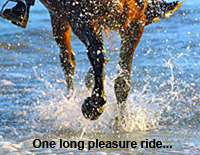 When working with clients, I see a range of issues that come up again and again in ex-racehorses. I also see plenty of unsuspecting owners who didn’t know what they were buying at the time.
When working with clients, I see a range of issues that come up again and again in ex-racehorses. I also see plenty of unsuspecting owners who didn’t know what they were buying at the time.
There’s a huge amount of love around, but the horse is often showing discomfort or pain, and the owner is only just realizing that (a) their horse may not be able to participate in the activities they’d hoped to experience together, and (b) getting the horse to a point when they can deal with these issues may cost considerably more than the horse did upon purchase.
It’s a sad situation. I believe that when looking at ex-racehorses, even those that have already had a couple of non-racing owners, you could do a lot worse than check for the physical issues listed here. Even better, get a vet to check the horse… but even then, you could run through this checklist before getting the vet in.
Don’t forget to read this guest post: 8 Golden Rules for Helping Your Thoroughbred Get Right Off The Track
There’s functional and not-so-functional when it comes to ex-racehorses
Not all the physical issues are deal-breakers, of course. A horse can have one or two and still be able to function perfectly well (although if it’s straight out of racing, some rehabilitative work is going to be necessary). A big part of your buying decision will come down to:
- the number of issues you can identify,
- the severity of those issues,
- what has already been done to assist the horse with those issues,
- how much they will affect the kind of riding you wish to do, and
- whether YOU are capable of providing the rehabilitation and retraining needed to support the horse through those problems – or if not, whether you can afford to pay somebody else who can.
The list that follows is by no means exhaustive – there are always more problems, especially as a combination of different problems can throw up further secondary issues. And I don’t go into hoofcare, which is worthy of another introductory article in its own right. However, it’s a major issue, so I’d recommend learning more about that too.
What I’ve decided to focus on here are problems that you can identify quickly and relatively easily. Most are visually identifiable. You can then get a more knowledgeable person to help you assess the horse or get a vetting completed before making a decision. Better still, do both.
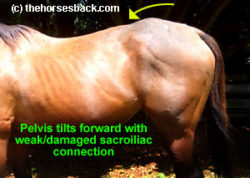 1. Sacroiliac Damage – Not Whether it’s There, but is it Slight, Bad or Appalling?
1. Sacroiliac Damage – Not Whether it’s There, but is it Slight, Bad or Appalling?
This problem really is the number one, as every ex-racehorse has damage to the ligaments in this area. Depending on severity, there can be lesions that have healed, or lesions that have resulted in lasting weakness.
Frequently, when damage to the ligaments is severe, there’ll be further changes to the pelvis that are also visible. These may may or may not have the same root cause (see 2, below). One general rule, though, is that the horse won’t be symmetrical.
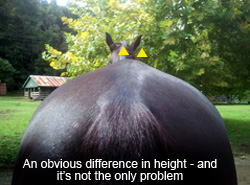 Major damage can rule out a future athletic career, while moderate damage may require rehabilitative work to strengthen the back and prepare the horse for future work. Minor damage isn’t necessarily an issue once the ligaments have healed.
Major damage can rule out a future athletic career, while moderate damage may require rehabilitative work to strengthen the back and prepare the horse for future work. Minor damage isn’t necessarily an issue once the ligaments have healed.
Check for: asymmetry of the tuber sacrales (the two bony ‘pins’ of the croup), with one side being more than 5mm higher than the other. The horse may walk with one side of the pelvis lifting higher than the other – a hip ‘hike’. The muscle development over the glutes on top of the hindquarters may be uneven. These horse are nearly always cagey about picking up a back foot – they’ll swiftly lift it really high and then lower it into position. The horse can also find it hard to stand square, instead standing with hind feet close together – one toe may be angled outwards. Always look for problems with the lumbar spine as well (see 3, below).
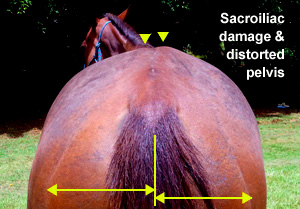 2. The Pelvis Can Be Equine Ground Zero
2. The Pelvis Can Be Equine Ground Zero
As well as sacroiliac problems, ex-racehorses can have other structural damage to the pelvis. Some of it you can see, some of it you can’t. The most important thing to do is check the pelvis for overall symmetry. What you’re checking for isn’t just pelvic rotation, ie. one side being higher or further forward than the other, but also distortion.
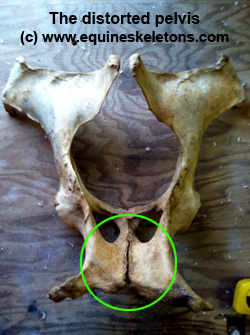 In horses that have had heavy accidents at a young age, the pubic symphysis (the lower cartilaginous join between the pelvic halves, directly between the legs) hasn’t formed properly. The pelvis may be forced wider due to impact or stress, and this part never joins.
In horses that have had heavy accidents at a young age, the pubic symphysis (the lower cartilaginous join between the pelvic halves, directly between the legs) hasn’t formed properly. The pelvis may be forced wider due to impact or stress, and this part never joins.
What problems does this cause? With a severely distorted pelvis, a horse can’t work equally well on both reins and may not be able to canter at all on one rein. These horses also have a higher risk of having hidden stress fractures – hairline fractures that can worsen after a further fall or trauma later in life.
Indeed, make sure that all the pelvic ‘bony landmarks’ – the point of hip, point of buttock, croup – are actually present. Sometimes fractures lead to ‘knocked down hips’ or one tuber sacral may have dropped due to a fracture of the pelvic wing.
Check for: Pelvic symmetry, by checking the positions of the bony landmarks. If you know the horse and it’s safe, stand on a box a few feet behind to take a look down the back of the squared up horse (if it can square up, that is). Otherwise, hold a mobile phone directly overhead to get a straight-down-the-back photo, ensuring it’s dead center. ALWAYS STAY IN A SAFE POSITION – CLIMB ON A FENCE TO LOOK, WHATEVER. JUST STAY SAFE.
© All text copyright of the author, Jane Clothier, www.thehorsesback.com. No reproduction of partial or entire text without permission. Sharing the link back to this page is fine. Please contact contact me for more information. Thank you!
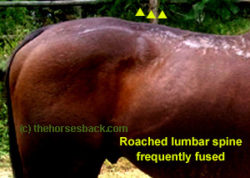 3. Heading North, South, East or West… the Lumbar Spine
3. Heading North, South, East or West… the Lumbar Spine
If you’ve found any sacroiliac or pelvic issues, you’ll probably find problems in the lumbar spine too. Lateral imbalance in the pelvis will, more often than not, rotate the lumbar spine to one side or the other. Lumbar issues can also be found all on their own.
 A long-term rotated lumbar spine will usually have some fusion between the vertebrae, and/or overriding dorsal processes (the part of the vertebrae you can feel). Fused areas are painful for the horse while they’re happening, and OK once the fusion is complete. But if fusion cracks, it can once more be extremely painful. Many horses compete just fine with some fusion, but if it’s severe, there’ll be problems with flexion, both vertical and lateral.
A long-term rotated lumbar spine will usually have some fusion between the vertebrae, and/or overriding dorsal processes (the part of the vertebrae you can feel). Fused areas are painful for the horse while they’re happening, and OK once the fusion is complete. But if fusion cracks, it can once more be extremely painful. Many horses compete just fine with some fusion, but if it’s severe, there’ll be problems with flexion, both vertical and lateral.
Check for: Use your hand to check the lumbar spine for the ‘lumps and bumps’ that can indicate overriding processes. Looking from the side, is the lumbar spine raised – ie, a roached back? This will usually tilt the pelvis back if it’s a longer term problem. If the pelvis is tilted forward, you’ll find there’s often a longer dip in front of the croup – the sacrolumbar gap is larger than normal.
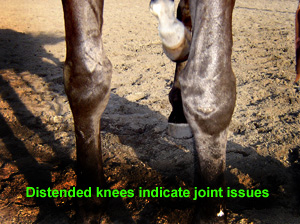 4. Knee Bones: Take a Bag of Chicklets and Shake Them Up
4. Knee Bones: Take a Bag of Chicklets and Shake Them Up
Or so said Tom Ivers, one of the original equine sports therapy experts and a racing trainer to boot. Equine knees are delicate and complex, with many small bones (carpals), and undergo a lot of stress in a racing career.
Problems such as slab fractures and bone chips in the carpal bones happen due to over-extension (when the joint is bent back slightly) at high speed, or from constant loading on the same bend. Then there are more complex fractures, when the carpal bones break into more than two segments.
Check for: Puffiness around the joint, especially in front, due to previous swelling in the joint capsule. Old bone chips and slab fractures may have been dealt with at the time, but there can be lasting damage within the joint that leads to osteoarthritis (carpitis) later on.
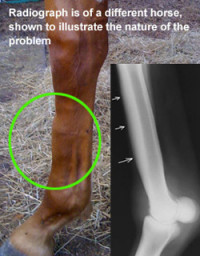 5. The Stresses Left by Sore Shins
5. The Stresses Left by Sore Shins
An ex-racehorse may have had an episode of sore shins in its early career. This is stress to the periosteum (the soft surface layer over the bone) caused by concussion – the body’s response is to lay down extra calcium to strengthen the bone. The bone recovers, but anywhere there’s been remodeling, there’s weakness in the bone.
If it’s severe, there may be an undiagnosed stress fracture that can go catastrophic under high pressure at a future date.
Check for: a curvature on the front of the cannon, which indicates that the problem was bad for heavy remodeling to occur.
 6. Tendons, Tendons and More Damaged Tendons
6. Tendons, Tendons and More Damaged Tendons
Injuries to flexor tendons are extremely common amongst racehorses, with the deep digital flexor tendon and superficial digital flexor tendon being the most affected. These can be relatively minor lesions, which heal up quite nicely, to more serious ruptures that end a racing career.
There is always a risk of re-injury due to the weakness, and in serious cases, a second rupture could be catastrophic. It often depends on the quality of treatment and length of rest given at the time, as well as re-conditioning before returning to work.
Check for: a thicker area of the tendons indicates an old injury that has healed, while a curvature along the length of the tendon is a classic ‘bowed tendon’, sign of a far more serious injury.
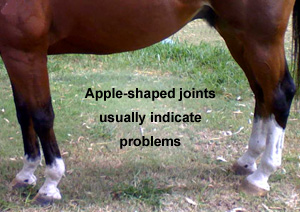 7. Small but Vital: Fractures in the Fetlocks
7. Small but Vital: Fractures in the Fetlocks
Fetlocks are vulnerable due to hyper-extension, when the back of the fetlock comes too close to the ground when all the weight is borne on one foreleg at high speeds. Extremely high forces occur at the back of the fetlock and pastern as the horse lands the forefoot. Poor hoofcare, in the form of ‘low heel, long toe’ imbalance, also plays a significant part in this.
With fractures, the big, big issue is the type and location. A damaged sesamoid (the two small bones at the back of the fetlocks are the sesamoids)can play havoc with the vital suspensory ligament. So if you see signs of a problem, you’ll always need to know more, and that will usually mean involving a vet.
Check for: Sesamoid fractures will show up as ‘over-rounded’ or ‘apple shaped’ fetlocks, where swelling from an old injury has disrupted the joint capsule and/or extra calcium has formed around a restricted joint. Are the fetlocks of the forelegs the same size and shape? If one joint is larger and rounder, or if the ligament at the back of the foot feels thicker, with puffiness above the back of the fetlock, be suspicious.
Original article by Jane Clothier, www.thehorsesback.com posted 9 Feb 2014. All text and photographs (c) Jane Clothier. No reproduction without permission, sorry.
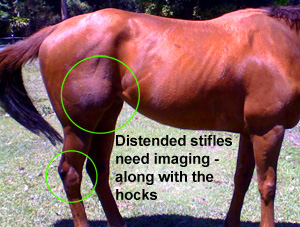 8. The Stifles Cop It, Nearly Every Time
8. The Stifles Cop It, Nearly Every Time
There are numerous causes for stifle issues in ex-racehorses, but you can take the view that if there’s a problem anywhere in the hindquarters, the stifle usually suffers. This includes any pelvic imbalance that leads to unequal loading of the hind limbs, never mind the forces of running on a unilateral bend…
Then there are the rotational twists that can happen in collisions and on bad ground. There are so many ligaments around this complex double joint that it really isn’t hard for it to get compromised.
Check for: A regular click as a hind leg starts to swing forward. This is the patellar momentarily catching, which can happens due to the lateral imbalance (causing misalignment in the femeropatellar joint). Other signs are visual: distension (swelling) of the joint may be visible from the side-on view, or from the front looking back towards the tail, depending on which part of the joint has been affected (femeropatellar or femerotibial).
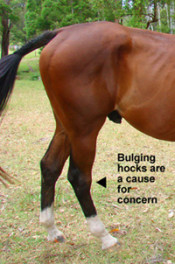 9. Bringing up the Rear: Hocks Are Vulnerable Too
9. Bringing up the Rear: Hocks Are Vulnerable Too
The hock comes under major stress due to being so involved in providing propulsive power in the gallop. As a major hinge joint, it is central to jumping out of starting gates/barriers, when it’s subject to the load of almost the entire horse. In the gallop, it must alternate between being compressed to absorb concussion, being rigid to build energy, and then extending fully to dispel energy and move the horse forwards.
Frequently, it’s doing this while subject to uneven loading on a bend. Then there are the unplanned twists and traumas. Well-conformed hocks may deal with this pretty well, but over-straight hocks and ‘cow hocks’ mean that the joint is less able to withstand high levels of work. It’s common for DJD to develop in the lower bones of the joint, especially on the side that’s on the inside of the bend the horse raced in.
Check for: look for puffiness on the face of the joint. Also look for bog spavins – these are specific fluid bumps on the front of the joint, which indicate underlying issues. Bone spavins are their bony equivalents, being hard bumps lower on the face of the joint, which indicate the presence of established DJD (arthritis). Also, listen for a crunching noise or a crack when the hind foot is lifted.
 10. A Crash and Bang on the Shoulder
10. A Crash and Bang on the Shoulder
Racehorses can experience awkward impacts at the base of the neck, above the point of the shoulder. It can happen when bunched-up horses collide or run against railings, during a fall, or through everyday routine, such as a severe knock against a stable door. One outcome can be damage to the supraspinous nerve, which runs over the face of the shoulder blade (scapula).
When damaged, this can lead to wasting or even paralysis of the muscles over the shoulder blade itself, which is a problem, because these muscles stabilise the shoulder joint. This condition is known as ‘sweeney’. Mild cases usually recover, but more severe cases can be left with permanently wasted muscles. With reduced function in one shoulder and a shortened stride, the horse won’t be suited to demanding sports.
Check for: a lack of muscle over the shoulder blade itself. This is more than just tight muscles – the spine of the shoulder blade will be visually obvious and easy to identify through touch.
And There’s More… There’s Always More
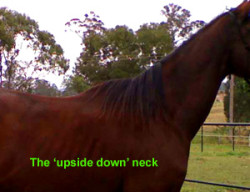 It’s hard to know where to stop with an article like this, but I hope this is a good start when it comes to assessing a horse. You may be thinking that many of the problems are those you should check for in any new horse purchase – and you’d be right. However, anyone who works regularly with ex-racehorses will recognize that there are certain sets of issues that come with these former athletes.
It’s hard to know where to stop with an article like this, but I hope this is a good start when it comes to assessing a horse. You may be thinking that many of the problems are those you should check for in any new horse purchase – and you’d be right. However, anyone who works regularly with ex-racehorses will recognize that there are certain sets of issues that come with these former athletes.
What I haven’t covered: neck issues are common (calcification at the top of the nuchal ligament, misshapen atlas and atlanto-occiptal junction, etc), hidden stress fractures (radius and tibia are most common, but also the scapula… and others), the fractured ribs that come with sideways impacts in a race, misalignment through C6-T4, and quite a few more… but all are harder for the non-professional to assess.
Other information is more of interest to people working in the field. For this reason, I’m adding some links below. Please feel free to mention your own in the Comments…
To finish off, here are two horses that raced in Australia, where it’s common to train horses at the very racetrack where they run most of their races. In the state of NSW, the horses run clockwise (the bay), while in the state of Victoria, they run anti-clockwise (the chestnut). A view straight down the ‘unstraight’ spine can tell you so much!
Has this Article Helped with your Thoroughbred?
If so, you can help me to help horses by making a one-off Paypal donation towards the site’s running costs.
Now check out this article OTTB rehabilitation: 8 Golden Rules For Helping Your Thoroughbred Get Right Off The Track
Questions, thoughts or comments? Join us at The Horse’s Back Facebook Group.
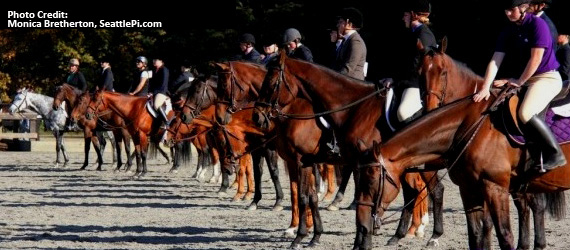
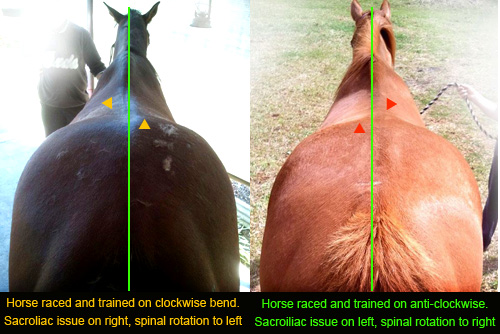
Good for all purchases.
Thanks Jim.
This is a great summary of some of the issues. I started riding OTT’s a few years ago and didn’t know any of this stuff, but gradually noticed similar dysfunction in many of the horses, just like you’ve described.
It makes me want to go back and say ‘sorry, mate’ to some of the horses who I can now see had physical issues which translated into hesitance or refusal of things I asked them to do.
Thanks.
Thanks for your comment, Kerry. I am really appreciative of your honesty. Creating such an understanding of the horse’s physical limitations is exactly what I’m aiming for. These magnificent animals give so much.
I rode a horse that was being used as a lesson horse. The owner told me the horse preferred to go round anticlockwise. With the information and pictures you have put up I am going to go take a look at that horse. I’m betting I find uneveness in the spine and pelvis.
Is there any sort of website out there where you can enter your OTTB’s racing name and look up any injuries they’ve had? I have an 8 year old bay mare whose hind end “slips out” occasionally. The only injury I can see is a bump on her spine about a foot from her tail…lower lumbar vertebrae. Any clue as to what type of injury this could be? Thanks
In Australia, you can see the records of how long the horse has ‘spelled’ for (ie, spell of rest) and that can offer some clues as to how well things were going… or otherwise.
In Victoria in Australia the http://www.racing.com/ website has a record of all of a horses races including photo finishes and stewards reports. The stewards reports of a race can give information about falls or interference that occurred during a race and sometimes injuries and vet feedback. I read through a friend’s horses history on it and his form was very consistent in his first 10 starts or so until he ran in one race where he was bumped at the start, badly interfered with but still raced on and came 2nd. I think that is where he hurt himself and there after didn’t really place again. Later he was found to have issues around his elbows. My mares half sister raced unplaced in group races early in her career, towards the end of her career she started to badly miss the start – my horse dentist suggested she probably had a sore back.
Excellent summary of all too common injuries….
I write up what I learn from others… it is good to share information that can make such a difference…
Thank you – this is a brilliant well informed article – i have shared it among my FB friends – I work in racing as a yard person and see so many of these problems on a daily basis – as they translate into behavioral issues they are ALWAYS disregarded by the riders/trainers as it just being a race horse ” its what they do” – it’s always a relief when they finish their careers in one piece and move on to another job but as this piece highlights so well their problems may only just begining ! x
I think you say it all there, Sally…
Really good article – I wish I’d had this information 20 years ago!
I feel that way about just about everything that I learn regarding horses!
Also thought maybe supra scapular nerve damage?
Point number 10 in the article…
Great article very confronting for a first time owner ofOTT.
SPOSE Depending on the level of horsemanship in later life makes huge difference.
I know I certainly had plenty of fun with mine, and set me up for many challenges.
I’d never disregard buying another if the right one come along.[just saying in passing ]
A great book read by Martinez I think don’t quote. What I got from that was right at the end.
Exactly what I just said above,never disregard the TB as a amazing horse to own.
TA
It’s about finding the right horse for the home, and the right home for the horse.
The last thing I’m suggesting with this article is that anyone should avoid TBs. Awareness and understanding is everything when it comes to any horse’s physical problems. I have seen horses with multiple problems taking part in ODE-ing – they will do it, and willingly so (being courageous TBs), but their problems have then grown worse and are eventually career-ending. I saw one that had been show-jumped into the ground with carpal arthritis and fracturing – it broke my heart to look into the proud eyes of that horse.
Yes a very good article, I’ll never own a Thorobred again, the one I had I raised,
but sold her, she would’ve made a good jumper, not a western trail horse.
She was a g-g-daughter of Naushua .I’ve seen Thorobreds with the bumpy lumbar
spine. I have AQH and their spines are in good shape, good legs and feet.
We see many of these structural issues not only with the Thorougbred but with the crooked riding horse at our training establishment. The crookedness leads to stress of limbs, ligaments, spine, back issues and often nervous issues. I have wondered IF the race horse was taught how to carry his body aligned/ bent and use his head and neck for balance on both leads , be balanced and supple what a better racing machine he would be. When I worked in stables in the UK in the late 60’s I lunged/ long reined and balanced the young horses before they were ridden and they worked on basic training of figures of eight before they were galloped.I noticed horse in Dubai were worked like this before galloping.
It would undoubtedly help! Running in an inverted posture on a unilateral bend isn’t going to be good for any horse!
I was stunned at the practice of training at the track that happens in many places in Australia, which only allows for one option when it comes to exercise. I remember one training telling me of his revolutionary idea – to swim the horse in the opposite direction in the pool! And yes, it’s a good idea, of course it is 🙂
Hi
I have been saying this all along, the Thoroughbreds don’t get the correct Training, they don’t Lunge them long enough and correctly, and don’t get Flat Work, and the biggest problem they are Ridden too yang!!!!!!.
To Lunge a horse correctly you have to be a Master, to understand what you see.
Thank you,
Harry.
I had my TB for a short time. She was a rescue and suffered severe seperation anxiety. Rest her soul as she jumped a fence and broke her shoulder. RIP Phoenix. She was broken in and discarded because of the seperation anxiety. So much that goes on in s racing world that is not known or discussed. This article was very informative and may explain some of my standards problems (diff breed but similar problems)
That is so sad, Tammy. I’m sorry you lost her in that way. Some simply cannot cope with the life and then fail to cope with ‘civilian life’. It sounds like Phoenix had the worst of experiences on many counts.
May I ask, if you don’t mind, did the scapular (shoulder blade) fracture or was it within the joint?
Excellent article Jane! I feel sorry for race horses 🙁
Hi – thanks for the article. I own 2 ex-racehorses, 1 of whom has been classed as having an asymmetric pelvis. I have owned him for a year and he is currently competing at Elementary level dressage and off to the regionals next week. Yes he requires regular physio and I put in lots of time making sure he was working evenly but he is a joy to own and would urge people not to be completely put off by owning an ex-racehorse, they may just require extra tlc to keep them in shape – but surely all horses deserve this. x
Absolutely Katie, I couldn’t agree more.
I can only reiterate what I said at the start of the article – are you able to work with the horse to rehabilitate it (you obviously are) and/or can you pay someone else to support you in the effort (you obviously can)?
What is simply ‘extra tlc’ and a no-brainer to you may be an approach that someone else never even thinks of. I hope, I really hope, that this article helps other people to do as you do 🙂
Awareness is everything – I can only repeat it, over and over – when you truly know your horse, you can give it the support it needs, whether that’s the re-education, moving differently under saddle, developing back strength through in-hand work… The TB is so often a willing and courageous horse, that a little support can often go a long, long way.
Thank you for posting this, and good luck next week!
riders and trainers dont ALWAYS disregard behavior issues as ” its just what they do ” most of us that ride and train are smart enough to know physical issues cause most behavior issues. If Im on a horse that doesnt want to train, I know there is a reason.
I think the person you’re replying to (in an earlier post) was referring to the specific yard she works in. At least, that’s how I read it.
Hi
I love TB’S they are fantastic horses i had a few, came to me for training, but not after racing, i love to have one now but i don’t have the facilities for training in the winter.
Harry.
Fascinating article. i am a Pilates trainer, and i see many similar problems in human beings who don’t consider the occupational hazards of their desk jobs. Not just the wrist problems from typing, and mousing from asymmetrically, but from looking down all the time and perhaps sitting twisted at their desks — short hip flexors, scoliosis, rounded lumbar spines, tight hamstrings — and the distortions that come from driving, tibial torsion on the accelerator leg, hunched shoulders and forward-head tilt, and so on. Indeed, I have these problems, or most of them, myself, but have found that with proper reformer exercises, I can unwind them a bit every day…. though at 67, it gets harder and harder to do that.
It’s very poignant to consider these brave animals, the races they’ve run, and see the results of asymmetry in their lives– and to see the capacity for insight into their histories that you bring to their care..Thanks for writing this.
Thanks for such an interesting response, Paul.
Yes, I have most of those issues too 🙂 My passion for writing this article has left me with a few more…
It has to be said, and I’ve not gone into it too much in the article, but asymmetry in the racehorse’s life is compounded by ‘too much too soon’. That’s another phrase coined by Tom Ivers, who I mentioned in relation to carpals.
I daresay today’s kids will be showing the effects of ‘too much too soon’ with the severity of issues currently considered occupational hazards. It would be interesting, in a way, to one day see what bone remodeling has taken place as a result of early keyboard and mouse overuse from childhood onwards… but that is an experience for future therapists!
I have owned 2 ex racehorses my mare who I bough straight out of training was very asymmetrical on her croup but with a long rest and then brought back into work slowly, lots of work with the perssoa she has come back a lot more even and happier in her work. My other is a gelding I bought cheap he had lots of issues but he has plus,s that outweigh the issues, he had separation anxiety he wanted one speed only he has suffered a hock operation because he had 3 pieces of bone floating about but now he is not so bothered when his friend leaves hm he is sound and I can ride him relaxed in a snaffle he currently babysit,s my youngster on the road and is so chilled out now and loving it was well worth the time and effort
That’s great to read.
I find this post very unfair !! there are plenty of ex racers who have excellent health snd can go on to have fantastic careers as riding horses!! This write up will put a lot of people off buying or taking on these wonderful horses and cause a lot more of them to be pts or worse!!
I would really love to see you post a write up on the damage done to a lot of the lovely warmbloods ect with being over jumped and dressaged from a very young age!!!!
I would like to know too about the damage done to WBs who are started, ridden and trained at a young age. Lunging a young warmblood is very bad; many people don’t know this. I studied dressage in Denmark; I was told not to lunge, and especially not before the age of 4. If the young horses are pushed (put into regular riding), usually by the time they’re 7, they’re broken down.
yes, everyone wants to slam the track, and we are hard on horses. no doubt. We use them, snd we use them hard. There are plenty of unethical horsemen in the race world. On the other hand, there are plenty of unethical horsemen in every discipline. Also there is just the cold hard fact that if you use something, its not shiny and new any more. Personally, Id ride a 3 legged Thoroughbred over an ordinary horse any day. Iv got a veteran of 69 races here at home, 15 wins, 18 seconds . almost $ 79,000.00 in earnings. His right ankle is fused. It doesnt bend any more. Yet, if I go out there with a halter, he walks over and sticks his head in and says ” lets go”. Anything I ask, he does. I dont ask much, but if I asked for his life He would lay it down, just like he did everytime he raced. He had that ankle the 3 years I galloped him on the track. and still won races. So dont any of you disregard a Thoroughbred brecause they are not shiney new perfect anymore. Like the lady says, help the horse as best you can, everything doesnt have to be perfect for everybody to enjoy themself. Except at the highest levels, there isnt much most riders are going to ask of a Thoroughbred that is going to exceed the demands of racing. Chances are if the horse is reasonably sound after racing, it can do for you. My little Cat was given to when they were done with him. He stands off that right leg alot, but he is still a warrior.
Your horse sounds like a superb character. I’ve always noticed that the ones who do well in racing are not just athletically capable, but they seem to have high pain thresholds and really aren’t that perturbed by physical problems. Referring back to the list near the start of this article: the extent of damage is greatly affected by “the horse’s mental and emotional ability to cope with physical problems (it varies enormously).”
Thanks for posting 🙂
From what I know of friends and personal experience, Joanna, this article will alert a buyer to problems to be resolved and ways to resolve them. It may well prevent a seller from offering an unsuitable horse to an inexperienced handler. Others in the field take all the information like this that they can find and accept the challenge. I’ve known some ewe-necked horses transformed into gorgeous dressage horses, e.g. Some people enjoy taking the wrecks and transforming them into pain-free and free movers with well rounded outlines under saddle. It’s all for the horseS.
No doubt there are articles on different breeds and their requirements/ best training methods. This article concerns TB’s and is factual and helpful. Why is it that some people can’t deal with the truth? Knowledge is power and all toward being aware of potential problems and/or reasons for behavioural and performance issues. A positive thing for both the horse and owner?
Excellent article. There were some things I did not even know. I’ve been riding OTTB’s for many years. In fact, Thoroughbreds are my favorite breed to ride and train, and it’s always so important to know about all of their physical issues and past injuries etc.
Karin
Absolutely correct a horse is not meant to be lounged. Have not ever seen a wild horse going in a cycle first right and then left.
To bad a horse can not tell the human what to and what not todo.
.
I broke in young tbs by long reining them. They weren’t lunged until they were 4 yrs old & in light ridden work.
An amazing and very imformative article thanks!!
I have a Paint that is suffering from the “clicking” you mention in the stifle. On Vet recommendation, we started her on Adequan and now supplements. Since it just started and was not evident prior to this time, we are thinking an injury of some type… possibly due to two falls she took. Clicking seems to be subdued and I’m not hearing it… something you don’t really mention in the article is how or if any of these ailments can be corrected or if the horse can be ridden comfortably (their comfort) moving forward. She is only 7 in March… I plan to only pleasure trail ride… she is a great grand daughter to Designated Hitter. Just don’t know what to expect!
Hi Cindy
There can be many causes of the dysfunction you have in your mare… direct injury to the stifle or problems elsewhere that are causing imbalance. It’s great that you’ve noticed an improvement though and here’s hoping she continues to get better.
When you say, “something you don’t really mention in the article is how or if any of these ailments can be corrected or if the horse can be ridden comfortably (their comfort) moving forward”… well, no, I don’t. There are so many variables, not just in the problems of the horse itself, but in the treatments used, interrelating nature of problems, 360 degree care approach used by the owner, tack used, riding styles… It simply isn’t possible to say “this problem is treatable in this way”. For example, if we say that strengthening the horse’s back is essential to overcoming sacroiliac damage, then the degree of success would depend on the way in which the owner decided to do this as much as the degree of dysfunction in the horse’s pelvic connections.
For this reason, it simply isn’t possible to provide the answers to questions that this article raises, at least not on an individual basis! I can only refer back to the bullet-point list earlier in the article, under the “There’s functional and there’s not-so-functional” heading.
I have 2 GORGEOUS ex race horses in Mauritius, their names are September Wind and Captain’s Cheer. I am a beginner rider and have a lot to learn about horses. I thoroughly enjoyed your extremely informative article. Both my boys retired in the first half of last year, with various leg problems but today they lead wonderful happy retired lives. They go for recreational rides every day with a bit of good exercise and of course loads of TLC. With patience, love and care and time to spend with them they have calmed down and are able to enjoy themselves. Understanding the problems/injuries an ex race horse has is essential and it’s this that people must be aware of so that they are the right horse for what you want. Being a beginner with horses all I want is to have my horses for recreation, so with the problems my boys have had, their new career in recreation is perfect. They are champions in their new careers and give me pure pleasure. I have only known thoroughbreds and LOVE them all! Here’s to giving ex race horses the retirement they deserve using all the knowledge of their pasts with injuries to make the best life for them and the perfect horse for an owner!
Lucky horses!
My mantra is pretty much “awareness is everything”. With awareness of physical problems in play, horses can end up with the right owner, and owners can end up with the right horses.
Great article. I treat lots of racehorses, nearly all of them have neck, pelvis, shoulder and rib problems.
Thanks.
Thanks for the article. After 20 years of not having a horse, I bought a $16 weekly lottery ticket, won a few hundred dollars, and bought myself an OTTB fresh of the track. Wouldnt swap her for anything, nor could any amount of money buy her from me. Does she have issues…..yes. I discovered she is very sugar sensitive, and developes Laminitis very easily, so is on a very restricted, but stable, diet. She has been free of it for a whole year now, her previous trainers were contacted to see if it had been an issue, none of them realised. How long did she race for with sore feet?
She has nerve damage in her back, however it seems to have healed, and doesnt pose a problem at this stage. She has a knee that has a lot of play in it, if it is still like that when the chiro looks at her again beginning of March, then any jumping is out of the question. She is girthy at times, so may have some old rib damage- she raced for 3 years.
She is the sweetest natured animal out, will do anything to please, tries her heart out and despite her problems, she will live out her life with me. Love her to bits.
I wish you both well.
I recently bought a 4 year old TB gelding that I was told was too slow for racing, had run “4” races and not done too well! Another major problem which isn’t addressed in the article is that many TB’s have laryngeal hemiplegia commonly known as roarers. He’d had a laryngoplasty or “tie back surgery” but this does not always fix the problem. When I started lunge work with him he really struggled to breathe and had a chronic cough sometimes at rest and also appeared to aspirate on his food!!!!! I’m not in a position financially to spend thousands on vets bills and surgery which might not even work so I very sadly sent him back to the seller and got a refund. TB’s are a magnificent gorgeous equine breed my horse had an amazing temperament very kind and gentle but the nature of racing I agree certainly takes its toll on these wonderful creatures both physically and emotionally.
Thanks for this post, which is certainly a sad one. These are the horses for whom a second ridden carer is less likely.
Great article that people should read BEFORE they purchase an OTTB. I am working on an OTTB with a club foot (high/low). I have before and after photos and would be glad to share. He’s on the case study page from my web site: “Club” Foot and Under-run.
Thanks Sandy. I’m going to post your link here, as you show good images of both high-low hooves and the ubiquitous low heel-long toe.
http://www.hosshoofho.com/club-foot–under-run.html
Add such hoof unbalance to some of the physical problems in this article and whoah, do you have a volatile mix of issues impacting on one another. I can’t stress enough that hoofcare has to be addressed as well as body issues, due to the strong interrelationship between the two. It is often impossible to resolve one without addressing the other at the same time, as so many bodyworkers and hoofcare practitioners are finding!
So informative! I’d love to see the same of analyses for Standardbreds, though I bet most of what you covered here also applies to them? Thank you so much for spelling it out.
Thanks for the article. I am about to go down this expensive rehab road with my OTTB but I’m staying positive and with great resources available these days I hope I can get him to a point where is pain free and we can live a long happy riding life together! I also thought I should mention I have noticed my horse sitting like a dog at times. I thought this was him being cute but now I think it’s related to issues in his back/pelvis.
I hope you find out what’s going on, Wendy.
Aim high with the rehab – you may land a bit lower, but that’s often a good enough place for most horses in order to live long, happy and comfortable lives!
That was a very good and informative article. However, I have a reservation to what you wrote about bucked shins, the formation of thicker bone on the front of the cannon bone occurs as a natural adaptation to training of the young horse which in most cases result in a strenghtening of that bone making it less prone to injury in the future, given proper care and recovey when the process is occurring. On an older horse I would consider a slightly bucked shin as more of a beauty flaw than a concern. Only in very severe cases or if there was active bone remodelling and soreness in a horse older than two would this bother me.
Hi Maria, sorry to take a while to get to this. It was this piece of writing in particular that made me think again on that subject (I’ve put the key part in bold):
The Dilemma of Bucked Shins in the Racehorse, by Daniel J. Burba, DVM, Diplomate ACVS, Professor, Equine Surgery, Equine Health Studies Program, LSU School of Veterinary Medicine
Introduction
One of the most common problems that young race horses develop is bucked shins. It has been reported that 70% of young Thoroughbred racehorses in training develop the problem. Bucked shins are commonly accepted by veterinarians, trainers and owners as a normal training event in young Thoroughbreds. Bucked shins usually occur in 2 year-old racehorses during the first six months of their training. The estimated losses to the industry as a result of the problem exceed $10 million/yr. Approximately 12% of horses that develop buck shins go on to have stress or saucer fractures later. ”
Stress fractures. The underlying cause of those apparently spontaneous complete fractures of the metacarpals that occur on the track.
So I find the pivotal point of your comment to be, “given proper care and recovey when the process is occurring”. As with other points in this article, I’d be looking at the horse as a whole. If the horse had a bunch of other problems, then I’d be concerned about the bucked shins, as I’d be suspicious of the level of care given by that particular trainer. If the horse were in otherwise good nick, I wouldn’t, as it would appear more likely that the horse had received better care during its training.
Great article, would you pls be able to advise, especial on 1 and 2 what category sight, bad or appalling, Did I say this is a great article, many thanks for sharing this.
Lisa
Thanks Lisa-Marie.
It’s impossible to be more specific, as you really need to look at a horse from several angles and to take many of its other compromises into consideration. Usually though, the greater the deviation, the greater the problem. We could take symmetrical as an ideal, but must remember that it’s only that: an ideal!
Hey there just wanted to give you a quick heads up.
The text in your article seem to be running off the screen in Firefox.
I’m not sure if this is a formatting issue or something to
do with internet browser compatibility but I figured I’d post to let you
know. The style and design look great though! Hope you get the
problem solved soon. Many thanks
Thanks Christina. It’s a premium level WP template so not sure why this would be happening. I use Firefox and there’s no problem, although I occasionally see it with some other sites. Did you try using Ctrl(-) to see if it would adjust?
Fantastic article. I’ve worked with horses for many years, ridden on several circuits, and with my first horse being an OTTB, I wish I’d read this before going to see her. Although she doesn’t have anything completely obvious, the description of SI asymmetry behavior fits her to a T. It’s not a horrible case, but I’ve aleays known she was a little bit more… Touchy.. About her right hind, and the lifting up real fast before letting you catch her hoof to pick it, standing with feet real close together, occasionally pointing her toe out… It’s right there. My vet never mentioned it during the check, but I will now go check her back more thoroughly and research ways to “even her out”, or see what I can do to make her life easier. Thanks!
Hi,
I have just half baited an ex race horse. I am a beginner rider at the age of 46 🙂 The owner is a more mature lady as well. Armour was never a really good race horse and was sent off to the slaughter house where he was rescued by the stables I ride at. His owner purchased him from the stables. He will never be compete and between her and I, we will not work him very hard. Low jumps a few times a week and mainly moderate arena work. Being so new at this it has all come as a bit of a shock that just after baiting him we find out that he is battling with his legs. He seems to trip a lot and on some days has a limp on his hind legs at the end of his lesson. As he is the absolute most amazing horse that just loves to please, he was used quite a lot by the stables prior to me half baiting with the owner. The physio has told us that he will need some physio done, but do you believe if it is just the two of us non competitive ladies riding him moderately and less frequently than the school, he will still be able to ride for many years to come. He is only 9 now and even though my time spent with him off the saddle is just as precious to me as on the saddle, I would dearly want to continue riding him as well. Very worried, not not know any of this when I went into it, but I am now too emotionally invested to step away.
It sounds as if your horse has found the right home! I’m guessing autocorrect has been at work on your message and that you’ve half bought him 🙂 He’ll no doubt do a lot better in a private home if you can build up his back strength, get great hoofcare to ensure his toes aren’t too long (a classic issue with ex-racehorse hooves) and ensure his saddle is a great fit.
I say those things because (a) good back muscle will really help to strengthen up that sacroiliac area, which could very well be involved with the hind leg issues, (b) long toed, low heeled hooves are often part of the tripping problem, and (c) poor saddle fit contributes to sacroiliac issues through the horse hollowing the back, creating tension through the long back muscles, and preventing the horse from moving forwards freely. If it’s an adjustable saddle, please take a look at my last article, Debunked: The Lie That’s Told About Adjustable Gullet Saddles, as it explains some fundamentals of saddle fit 🙂
On top of that, the more you can learn about his joints the better. This reply isn’t any kind of assessment, obviously, so get professional opinions where you can – and don’t just ask one physio/bodyworker, as we all have different perspectives and knowledge areas.
Wishing you all the best – it sounds as if a great relationship is developing there!
Jane@Ottb Just want to let you know I came across this by accident , have read this far and am totally impressed with this site and your input…. I learned to ride on a schoolmaster who was originally off the track, and adored him. My instructors helped me to buy him, saw all the probs at the inspection and knew he would be perfect for me! I had him for 10 yrs, an RDA pupil of mine got her confidence on him at shows and he parted with me when he was 26 after an amazing time together. I had to have him put to sleep as I knew the medication in his retirement was no longer working:(
I bought another tb who was not raced but had been a level 2 horse who also taught me much and I had to have him put to sleep at 28!!! I love reading your explanation of what happens to them as I had instructors who told me this but most people don’t:)
I started riding at 50 and after my two gorgeous Schoolmasters I now have a Clydie cross and am happy to put into practice what my boys taught me:):)!!!!
A fantastic comment, thank you Alison.
These horses have huge hearts and inspire passion in those who work with or own them.
I too know of a couple who have been at an RDA centre. Their ageing bodies had slowed and the physical problems were taking over at this later stage in their lives, but they still gave so much. This after racing and then a post-racing career.
As a bodyworker, I adore the sensitivity and responsiveness of thoroughbreds and, in many who have raced for years despite physical problems, the colossal dignity and pride.
Great read! Really makes you think. I bought my OTTB really only to save his life, he skinny and hatefull, and to be honest, ugly but after the lady who owned him said he was going to auction or “dog food” as she put it, I told my mom he was the horse I wanted. It took years of vets and farriers and ground walking/work to get him happy and comfortable. He will never be the next CCI horse but he’s become my baby and best friend, now at 20 years old he goes on occasional trail rides or is being a babysitter for my 2 two legged babies. It’s sad to see how much horses/animals will go through and put up with just because humans ask them too.
And a great reply, thank you!
Super Girl…I love this as it doesn’t matter why you buy them they win your heart:)
Interesting article. I have an OTTB and can relate to quite a few of these – and would add hoof issues. My guy has very thin hoof walls and this has caused lots (LOTS) of problems for us. He’s on hoof supplements to help his hoof from the inside out, probiotics to help maintain weight, joint supplements and injections and chiropractic adjustments. He’s only 10 years old. I’m not sure all this will amount to him ever being competitive but at least he seems pain-free now. We’re going slowly back into training and I’m careful to recognize when we’ve reached a limit. It seems most TBs want to please and they will go above and beyond for their person – whether or not it hurts or they should. It’s up the person to recognize when the horse is giving too much or shouldn’t be pushed that hard, you know? And sometimes the signs are subtle. All and all I don’t regret buying my guy at all. He’s expensive, high-maintenance, definitely frustrating at times and melodramatic…but he’s also gentle, trusting, loyal, clever, trainable, personalty-plus and a very dear friend.
That’s a lovely post – thank you.
I completely agree about hoof issues. I’ve added a link somewhere up there in the comments, but don’t feel qualified to write up hoofcare on my own – I may enlist someone to help me with that one! It’s something I see a lot of as a bodyworker, with low heel-long toe being the most common, closely followed by high hoof low hoof (forefeet).
I’m so pleased I came onto this site ….by accident…as we all need help to realise our horses will go way beyond their pain barrier to please us! In my short(only 15 yrs) with horses I am continually amazed at what these beautiful animals go through for us! I am totally committed to learning as much as I can to make my girls life better for belonging to me. I no longer have TB but i need to learn all I can for any horse I own:)
How do I build up my OTTBs back muscles? You mention it helps to do this, but what is done to target these muscles. I have an 18 year old exracer who raced for 7 long years, 55 starts. He has Native Dancer bloodline. He hurts every day, turns stiffly, trips a lot just walking around from neurologic issues in right front, but is a great sport about it, as long as he has his bute. Every now and then, he will get fired-up and race his girlfriend (a 4 year old Mustang) in his turnout (I can tell he lets her win, as he still can fly and gain speed on a dime), buck, kick up his heals, he still has it, but the next day he is quiet and laying low. I do not ride him, due to the tripping and we live in a very rocky dry area of Arizona and his hooves are thin and bruise easily from the rocky stoney ground. He’s living a good quiet life tho, spoiled and the better for it. Can you suggest any good exercises for him, beyond just walking, or easy challenges to keep him from feeling bored. He is extremely intelligent and a quick learner. He performs tricks, bows, salutes, nods yes, counts with hooves, holds flags, opens gates. He loves routine and likes to do things the exact same way every time and will beat me to it if I take too long (in his opinion). He’ll just go do what he is supposed to do without me, cracks me up.
Wow, I have no advice but just loved reading your story Patricia, gave me goosies, good ones. My OTTB is 9 (we think, saved from a slaughter house), he has so many of the traits you speak of and I hope to have many happy riding years with him still before he also enjoys a well deserved retirement. These horses are just too precious. My life is so much richer for all he has taught me.
I agree with Wendy – what a lovely relationship you have!
Last weekend, I had the privilege, if we can call it that, of seeing an ex-racehorse on the dissection table of Sharon May-Davis (see the elbow arthritis article on this site).
We were all stunned by the extent of the cartilage wear present in a horse aged just 9 years old, who had only had 10 starts. He’s going to be the subject of an article on here in due course.
My concern is that with an older TB, if we’re to start doing back development work that the body isn’t used to, we’ll be working against spinal fusion (lumbar and cervical) and will cause the horse pain. I’m referring to in-hand work that encourages and assists the horse in developing some self carriage. That doesn’t mean that gentle in-hand work to strengthen and, just as importantly stretch, the back and neck muscles is a bad idea, far from it!
There’s an e-book that you can buy in English on this site: http://www.lungeing.com . It’s soft and gentle work, with no pushing the horse up to its limits, and certainly never beyond. It’s classical work for the lay person, the ‘ordinary’ horse owner who just wants to assist their horse. What I’m clumsily trying to say is that it’s not about preparing for dressage competition (although you could use it that way if you wished). Take a look at the information and see what you think. Everyone I know who’s tried it has really enjoyed it and the horses seem to appreciate the support offered by the owner walking with them, rather than standing in the middle holding a lunge line 🙂
As well as NSAIDs, you could also look at a joint supplement with glucosamine, chondroitin and hylauronic acid, or possibly pentosan. I guess it comes down to preference, as well as trial and error.
Hi Jane, just read your reply to Patricia. On that note and bearing in mind that I am a VERY lay person on the subject, would putting too much work into bringing my horse onto the bit may be causing Armour pain. I have been putting quite a lot of work into this to try and help him strengthen his back, but this is the only time he starts playing up and really does not enjoy it.
I couldn’t say… just the words “on the bit” raise so many questions about training methods that without knowing how you work your horse, it’s impossible to determine. I don’t consider myself qualified to comment on those areas anyway, although like everyone I have my views!
The more you know about your horse, the more you understand the possible issues in the body, then the better qualified YOU will be to understand when he or she is working near their limits.
Wishing you all the best 🙂
Such a useful article nicely written. As a physical therapist I also see so many OTT with the issues you describe here. I was lucky enough to work for a TB trainer in my grooming days who also show jumped. All of her horses were schooled on the flat as well as race trained, so of course now I wish I could go back in time and take photos of them to compare.
Thanks for sharing your work with us all.
Hi Juli, thanks for the feedback, which is much appreciated. Yes, if only more trainers realised that flat work and working in both directions will help their horses to perform better, and for longer! Radical thinking, eh?
Amazing, informative article. I will refer back to it, there is so much great detail. And reading everyone’s comments, and your thoughtful replies to them, is also delightful.
The one thing I want to add is, don’t neglect yourself when you are riding one of these fantastic animals. (Or any horse, really. ) I ride an OTTB who not only was at the track for a very long time, he also had Lyme disease. He was pretty cranky, very sensitive(hated being brushed), weak in the hindquarters, and often very stiff. We’ve been doing solid dressage training, hacking out,weekly hill work and lots of TLC, but I (okay, my trainer!!) noticed I was quite crooked. I had never tried chiropractic but after seeing the difference it made in the horses took the plunge. Breakthrough!
We can now canter to the right:-) Not perfectly, but drama- free and hopefully pain free for my friend. He has come such a long way, and has forced me to as well, by being so incredibly sensitive to the tiniest adjustments, bad and good.
Really enjoying reading this column. Thank you.
Hi, it’s lovely to hear of success stories. They deal with so much and it takes insightful owners to recognise it all!
While he can manage the crookedness, with your help (and your trainer’s), don’t forget to get him some muscle therapy work as well, as there will invariably be tensions building up. Maybe you’re already doing this, in which case, forgive me 🙂
Wonderful article!!! thank you for being so detailed and including picture references! Thanks for this article- LOVE IT!!!!! LOVE IT!!!!
My 14yo daughter purchased an OTTB gelding, he was quiet willing and sweet. All was going sweetly and he started stopping at small cross rails and soon escalated to rearing when not wanting to go forward. He was screaming pain to me, but so many more, or so I thought experienced horse people told me to get rid of him. Thanks to a wonderful friend who got me onto an amazing acupuncturist, he was diagnosed with inflammation of his sacro joint, and then referred onto a wonderful equine vet, he had to get a long lasting cortisone injection into both joints and my daughter had to follow a strict exercise rehab program, he is now back to, if not better then before. He is the love of our lives and my now 16yo daughter has purchased herself an OTTB mare,we love the trainability and heart of the OTTB. Thanks for a great insightful read
I have an 8 year old TB that didn’t really race (too slow) but he also demonstrates a lot of the issues you have outlined. After returning to riding after 20+ years off, it was a shock to the system (as I only had low maintenance ponies previously), to have a horse that seemed so high in maintenance. However, I wouldn’t give him back for anything in the world. After a tough 2 1/2 years we have learnt so much together and he has taught me so much. I now have a team of ‘therapists’ that I can call on when he needs smoothing out and I am about to undertake a 2 day massage course so I am help him out when I need to. We are a very good team and undertake low level competitions and I am teaching him to joump which he loves! His most favourite thing in the world is going to the beach!
Horses are often treated like machines and discarded too much when they are broken. I wish more people would take the time to listen to their horse and be more understanding that when they don’t want to do something, 99.9% of the time it’s becuase they cannot or it hurts too much to do the task that is asked.
I have learnt that horses generally are not naughty, they nearly always have a very good reason why they will not comply and we need to start listening.
My horse will be with forever for many years of fun riding and a retirement he deserves.
Thank you for the excellent article, Michele of New Zealand
You’re welcome… it’s a pleasure to read a comment such as yours, as what you’re doing is what I believe these horses really need. Well, maybe what they really need is not to get quite so done over in the first place, but that’s another discussion!
Wonderful article! I have a 19-year-old OTTB who looked clean when I bought her five years ago, and is going strong. I realize it’s probably different for each condition you list, but can you give a general idea of when the problems you describe tend to appear?
I’m sorry to have missed this comment before now. These issues can be seen in horses of all ages – obviously, arthritic issues are going to emerge more strongly as the horse ages. It’s possible to see changes in the sacrolumbar area very early on, although it’s less visible in horses in racing condition with highly developed muscle. I doubt that you’d be seeing new problems emerging in a 19yo, so if she’s going great now, that’s good news 🙂
Great Article Jane. Sadly we see so many horses here started too young. these are apart from race horses which also suffer by being started too young. regards Bec
You have done an excellent job of showing some of the issues with racehorses. I am a TB trainer in USA and have written the book, Backyard Racehorse. I would like to send you a copy as I teach common sense training to get the horse to the races and doing so with no medications. Many of the issues shown are because the horse was not properly monitored in the development process. With all the knowledge, the horses are still pushed too soon …
Absolutely, Janet, and while horses are raced as 2yos and there’s an economic imperative for trainers to gain results at the earliest stage possible, this is likely to continue. It’s wonderful to hear about your work and I’d certainly like to see the book! There are trainers who do it the ‘right way’, but sadly, until these are associated with major winners, it’s unlikely there’ll be an industry wide shift. I’m definitely interested to hear your views on this.
I was glad to get notice of Florida horse trainer, Janet DelCastillo’s interest in thehorsesback.com. I spent a week with Ms. DelCastillo watching her train, attending the races with her and her horses. (A great way for Canadians to keep warm just now). She showed us how to find out when a horse was sore even though the horse was not obviously so. Her horses are trained for the gate using a simple set up. They spend a LOT of time at liberty and schmoozing. They are only caught up to train, to race, to check for any indication of being off or sore or hurt in any way from another horse’s kick, or work, or whatever. Imagine being able to do your morning gallops through an orange grove and enveloped in the scent of oranges and horse. We also learned how to buy a race horse and do our homework first to spot problems which could be developing in a seller’s stable. The horses were level-headed, good to work around. The whole experience continues to serve me in my own research and publishing and increased my appreciation for the Thoroughbred
. It was so encouraging to meet Ms DelCastillo and like minded people in the race horse industry.
And I’m looking forward to reading Janet’s book 🙂
Re: The horse’s back. What is the effect of road transport, where the horse supports extra weight on spread-eagled hind legs, on the pubio-femoral ligament and sacroiliac joint? Does offering the horse more space to spread its hindlegs during road transport help? What is the effect on the sacroiliac joint of supporting extra weight in an unusual posture? Over a century ago, Francois Baucher demonstrated the amount of weight transferred to the horse’s hindquarters when the head is held high (as with check reins). Gail Williams, a licensed therapist in the UK, has treated a pony’s sacroiliac area following long transport. I have a photo of a horse which was euthanized when during transport it was reported to have suffered sacroiliac injury. There has been a debate about the effect even a small cantle pack has on the horse’s spine and sacroiliac area. Could this be another area of study much like the Holmes 1960s observations on how the practice of tying a horse’s head in conventional transport led to respiratory problems? (This was followed up by the 1990s Racklyft/Love work on the damaging effects of tying a horse’s head where it can’t get it below wither level resulting in respiratory distress). Anybody doing any study and prevention–if needed–on this or are we just putting out brush fires?.
Awesome read!!!!! Thank you all for making life better for horses!!!!!! The one who cares is the one who wins…
Great article, with very good information that is valuable for any horse owner. What I do miss is the emphasis on the young age that these horses are trained and raced. These are babies doing power lifts it is horrific. A horse is fully grown at the age of 6 years. So the most wear and tare is caused by putting so much pressure on bones that are not fully grown. No wonder shins are painful and legs snap. Maybe it’s time to take a closer look at the race industry and let your voices be heard. You have actually made a list of evidence of animal cruelty caused by the racing industry, a bit ironic.
Thank you for the feedback. But please tell me, where is the irony? You have made the connection – and so do others! Now read by over 130,000 people (Apr 2015), this article is out there on the web, being used as a resource by other writers, instructors, trainers and campaigners. There are many types of drum that we can bang, and many ways in which to bang them. We do not all have to pick the biggest drum and do it in the loudest way possible! There is no shortage of anti-racing writing out there, no doubt being read mostly by the people who already agree with it. I do not wish my writing to be in that category – I am for helping the horses that are already out there, the ones that I see in my capacity as a bodyworker, who display this multiplicity of problems.
Jane I appreciate your article, I really do. And maybe my words were a bit harsh, sorry about that.
I think maybe you could have explained a bit more why it is that these horses are in such a bad state without your article becoming ‘anti-racing writing’. That would also be useful information for all horse owners and trainers etc. I am also a therapist and work with TB’s and also Arabian racehorses. The thing is it makes such a difference at which age these horses are trained. The Arabs I work with have started at 3 years of age, which is still young but some of them already 9 years old are still performing well on the race track. This applies to all disciplines, ideally I feel horses should only be ridden at 5 years of age so they get a proper chance to mature.
I own two OTTB’s. One I purchased from a trainer & he has lived up to every expectation. My second is a rescue. I adopted sight unseen from a killpen in PA. I read all of your descriptions & details but I find myself blind to being able to notice these in my own horses. Do you recommend someone or somehow that I’d be able to tell (of course he is being checked out by my vet in 2 weeks). But for future reference of recovery and potential new purchases as my eyes are not trained to look for such things.
Thank you.
Hi, thank you for your comment.
In response, yes it can be hard to see issues, as there is much to distract the eye and it definitely takes some practice with body issues to get your eye ‘trained’.
How wonderful that you’ve adopted an ex-racehorse. A horse from the killpen obviously comes with a high risk of problems, although there’s also a high chance that it will be as good as horses straight from the trainers (or as bad, depending on the horses’ fortunes!). It may be worth establishing a relationship with a good bodyworker in your area, so that you can look horses over together? I’m not suggesting that you don’t have horses vet inspected, but put the two viewpoints together and you can end up with a really good overview. Now that you’ve found this article, which I always intended to be such a checklist, it should be easy to pass the link on 🙂 I would always recommend a bodywork schedule for OTTBs anyway, as there are so many issues to be managed as the horse adapts to civilian life.
I wish you all the best!
Jane
We have 2 ex racers. One we cant keep sound as the very kind racing people shod her with too small shoes so she couldnt pul them of ( something she has never done with us in bigger shoes) just them being lazy and be damn to the horses comfort. I hope they are made to walk around in shoes to small and see what it does to them. She also is very stiff in the hocks and has cortisone injections. Her sacroilic joint is damaged. She will probably be put down due to her first years “care” in racing.
Our 2nd ex racer is so traumatised from being electrocuted in training to make her jump out of the stalls fast that we have mental issues with her a tight spaces. Her spine is also damaged from being back too young.
Personally, i think if we dont change the law and stop the racing fraternity from backing these poor horses so young they should just be shot when they have finished racing as they come out of racing with so many physical and mental traumas. They really have suffered enough in their first few years.
great article, i would be really useful if you had any findings on kissing spine – such a big issue especially with the use of cortisone injections whilst in racing to mask the problem
Hi, thanks for your response to the article! I’d like to write about KS at some point, but as you say it’s a huge subject, and obviously not just confined to OTTBs. In this article I wanted to concentrate on the most obvious, and visible, issues that owners and potential owners might be able to identify in the horses.
I really appreciate that before starting on the problems of OTTB’s you clearly state that it isn’t that horse racing in general that’s the problem. “As in any sport, there are things that are done well, and things that are not done so well. Informed training and misinformed. Well judged and misjudged. Just as in the rest of the equine world.”
I worked for decent trainers. . .not perfect but way better than what the general public imagines. I adopted one of my mounts and we both left the world of racing. Later I adopted a QH/WB mare who has had a very easy life by comparison. I’ve had equal issues in soundness with both horses. Thankfully, my OTTB was forced to retire after 3 races and he didn’t start racing until he was 4 (still young, but older than many).
This is a wonderful article and I hope that more people think about what they are getting into when getting a horse. It could prevent a lot of heart ache.
Thanks, I appreciate your comment in return!
The reason I wrote the article, as you’ve pointed out, wasn’t to say that only OTTBs have these issues – of course they aren’t the only ones. There are bad breeding decisions, early training and over training issues in all disciplines.
But I believe that anyone working in the bodywork sphere for a period of time will notice the sheer number of problems that OTTBs present, to the point where it’s usually possible to identify quite quickly those horses that have previously raced, as opposed to those that haven’t. I can often extend this to horses where the new owners say the horse never raced, but on further questioning acknowledges that the horse did in fact get trained and ran trials as a 2yo, before exiting the sport. It simply never competed!
I also think it’s fair to say that many of these issues add up to (ridden) career-shortening complexes… I have seen some heart breakers very recently 🙁 On the positive side, I think the horses who don’t present problems are those that have been lucky enough to fall into the hands of the more aware trainers, of the type you’ve described, and who are probably of good conformation and natural athleticism, and have good hoof structure, all of which equips them to withstand the rigours of intensive work at a young age. If only that were a breeding consideration!
All I can hope to do is raise awareness of the problems the horses experience and hope that there’s some way of influencing for the further good of the horses. Taking polar positions and being antagnostic will achieve little!
the left scapula seems to stick out a bit. The horse has no visible signs of injury or unusual gait. There is the same reaction when both sides are manipulated. The horse seems to have no effect from this. It is an ex race horse. Is this most likely something to be concerned about?
Dave Beveridge
dave@beveridges.net
Many ex race horses have a good life. I have one from Arizona that now resides in Saskatchewan, Canada. He has been with a new buddy for years and is well taken care of. His workout nowadays consists of outings to fantastic prairie and trails through forests. From what I can tell he is having fun… even gets scare the sh*t out his owner by testing his old racing ways. He seemed to be a little testy when riding but we now have an agreement where he gets to stop and eat the green grass once and a while. He now thanks me by being perfectly behaved.
Good article but I wish you would of put solutions and stories of the horses who came back to “life” after the track. I just bought (September 2015) 19 yo tb mare at a local sale. Out bid the kill buyer. I almost took her back cause of problems with her neither region but luckily antibiotics and turpentine took care of her problems! And when I ride her she did great! Yes she has a few issues ( Anxiety at first and hates my straight load trailer) but nothing any other horses would have! I hope to breed her to a Lusitano, Irish Draught, Thoroughbred and get a baby from her. She has great confirmation, great temperament and doesn’t look a day over 10 years old! Right now I just trail ride her which is mostly what I wanted to do with her originally and plan on doing some western dressage to keep her in good shape.
Hi Melissa, thanks. Good to hear that your horse is going well. As I keep saying in the comments, this article is about the right horses finding the right homes, suited to their phsyical capabilities. If I added all the things people suggest, it would be a book! I’m a bodyworker and this is a site about bodywork and health, so that’s what I write about. Did you see the guest post, “8 Golden Rules For Helping Your Thoroughbred Get Right Off The Track?”
Wonderful article, thank you! Let’s not forget, the overwhelming cases of ulcers and the myriad of different ways they effect each horse.
Thank you. Just what I needed. I was thinking about enquiring about an ex racer (specifically a hurdler) of 12 years old who had a 9 year career but is now being retired. Having second thoughts now as don’t want to be lead by heart rather than head and want to do what’s best for him and me
I don’t know if it’s just me or if perhaps everyone else encountering issues with your blog.
It appears like some of the text within your posts are running off the screen. Can someone else please provide
feedback and let me know if this is happening to them too?
This may be a issue with my browser because I’ve had this happen before.
Cheers
Like others, stumbled upon your site. Thanks for putting things in perspective, including the ++’s which are many!! I have a 22 yr old TB gelding (presumably never raced, but who knows what his training was?) who still looks (and at times acts) like he is an early adolescent. He is in his best shape ever – mentally and physically, mainly due to our lucking into a coach/trainer who appreciates and knows the breed inside out having worked for years on the track and at some of the big breeding barns before coaching; she also does body work and happens to be married to a barefoot ferrier. We no longer jump (although he still indicates his desire to do so when we’re in the arena with others) , but both he and I are doing lower-intermediate level dressage with considerable benefit to both our bodies/carriage!! Despite some bumpiness in our early years that I now see as due to gaps in our “team” and hence info base, he has developed into a willing partner who never fails to give me solid, honest feedback I need on my aids, etc.and is a joy to ride, even at his ripe old age!
Fabulous! There are so many things I like about this story!
Really great read. I bought my first OTT TB in August. She was almost a give away so I didn’t bother with a vet check and the viewing was cut very short by foul weather. Since getting her home I’ve noticed that her front legs sometimes shake and appear to not lock in. Some have said maybe her heals were/are sore so they’re bending forward to relieve the weight. Anyone had shaking front legs?
Hi, thanks for your feedback. In this situation, I’d be asking your vet to check her knees and possibly fetlocks. She may well have underrun and therefore painful heels, but personally I’ve not seen shaking associated with that. I hope all goes well with her.
I do not leave many comments, but i did some
searching and wound up here Buying an Ex-Racehorse: Can You Spot the Major Physical Issues?
– The Horse's Back. And I actually do have a couple of questions for
you if it’s allright. Is it simply me or does it seem
like some of the remarks come across like they are written by brain dead
people? 😛 And, if you are posting at additional sites, I’d like to follow anything
fresh you have to post. Would you list of all of your social sites like your twitter
feed, Facebook page or linkedin profile?
Hello there, and thank you for commenting! I don’t comment on other sites either.
Your question about the remarks… I really don’t know! The article took off very quickly after I first posted it, in fact is shot off before I had chance to promote it anywhere. I think a lot of people stumbled across it who maybe weren’t really looking for this kind of information. Not all comments need to agree, but I’d say there may have been a bit of wilful misunderstanding going on from some people who felt protective about their own horses, which they felt were being criticised. And I do wonder if they’d really read the article, as I suspect skim reading came into it too.
I’ve since added the byline under the blog: Body Talk for Thinking Owners. I’m adding a tag line to my bodywork practice too: Bodywork for Horses with Thinking Owners 😉
I haven’t much time to write posts, so any that I do will be appearing here. I’ve a sign-up list so that you can get an email when a new article goes up, or else there’s a discussion group on Facebook for people who want to keep it going: https://www.facebook.com/groups/thehorsesbackblog – I’ll flag up new articles there too. No twitter any more… I have a LinkedIn profile but don’t use it. My Australian practice page is http://www.facebook.com/balancedhorse
I bought my TB 11 years ago. He was 3 at the time. He raced once an his jockey was mike smith. He just didn’t want to race but he’s is one of nices boy I could bring into my life. I can’t say I’m any great rider an he understands that. He sure has made life fun an wonderful. He love to jump more than dressage but he always comes home with ribbons.
I’m lucky my boy doesn’t have any of these problems an I’m sure glad he wasn’t a throw away.
He has a big heart an lots of love to give me. My advice is if your interested in a TB get him or her checked out by your vet. Have your trainer go with you.
If anything happened to my boy I would get another young TB who didn’t like to race an just wanted to smell flowers an we do a lot of that together. I was so glad he’s in my life an I think he feels the same.
Sorry! Here I go again bragging about my boy. I just can’t help it!
That’s lovely! I agree so much about the vet check. Going in with your eyes open is so important!
I am looking at getting an ottb but I want to make sure they are 100% sound before I get them. Are all of these things included in an in dept vet check or are some of these more of the side things that vet’s don’t look at?
Hi Ally, if you’re looking for 100% soundness, you’ll need radiographs of joints. The best thing is to talk to your vets and discuss the level of examinations they offer.
This is a great article! I am getting back into riding I used to barrel race arabians which were hot and moody. But I was a professional athlete in gymnastics and have so many left over spinal injuries ankles and knees. I am looking at an OTTB from the owner of the barn I ride at. I’m really torn because I am nervous about all the possible injuries the horse could have but on the other hand think wow what if someone looked at me that way as an ex athlete!! I sure will have a vet check and do more research to make a well informed decision before purchase so thank you!!
Hi Kim, thank you, I am so pleased with what you are taking from this! It is all about knowledge of a horse’s problems and recognizing its physical limitations when matching OTTB to second career. I hope you have a brilliant new relationship with your horse, when you find him/her!
What an amazing article…i have started doing equine body work and this information will be invaluable in helping me decide how to help these beautiful, amazing, warriors…bless you…
What a superb article. I only wish I had found this years ago. Here I am reading this in 2020, and I am sorry to say that whilst I am passionate about Thoroughbreds, I would not buy another out of racing. I have owned 7 over the past 20 years, some purchased for big sums of money and fully vetted, and not one has been sound. The list of ailments and unsoundness I encountered reads like a catalogue of those described in detail in this brilliant article.
Through the COVID19 Pandemic, it must be noted that the selling price of off the track TBs in the UK has trebled and quadrupled, and yet people are still buying (as I did on occasion) sight unseen, in response to adverts regaling these horses as ‘Great Eventing prospects’. It must be understood – most do not go on to event, some don’t even manage life as a hack because of their temperament, but more so because of the injuries they have sustained as a by-product of being in racing. I will say this, buying the horse, whatever the price is easy, its the ongoing and unexpected costs and management that can shock many with these Thoroughbreds.
The most common and debilitating issue encountered in ex racehorses is with their feet, and I am experiencing this first hand right now with my lovely 6 year old, 17.1hh TB gelding. Racehorses are not shod for hoof health, they are shod for ease and speed – so all come out of racing with low heels and long toes; this results in a high risk of Navicular, and Negative Plantar and Palmar angles, which if left untreated can be career ending. NEVER let your farrier tell you that ‘All TBs have rubbish , flat feet’ – a good farrier will tell you that racehorse feet must be transitioned and corrected to support a long, useful, sound life. This takes time, money, patience and often a year or so downtime to get them right. NO FOOT – NO HORSE.
The Thoroughbred is a wonderful animal, they deserve a chance of a good life after racing, and my only advice to anyone considering buying a horse out of training would be this; keep your dreams and expectations in check, and go in with your eyes and your wallet open.
I never achieved my racehorse to low level eventer dream, maybe someday with my current TB, but put it this way, I have 2 beautiful youngsters in the field, both Irish Sports Horses, and both with excellent feet…
Oh… I hear you. I feel it. All I can say is that I’ve learned so much more since writing this article, that I will be creating an update – a short blog and a video – in the near future. I wish this didn’t have to be the case.
Often a horse which can no longer healthily withstand the rigours of training and racing, can tolerate the less stressful demands of showjumping or eventing. Low level eventing requires horses to travel across country at 300 to 400 metres per minute whereas racing thoroughbreds often sprint 1000 metres per minute.
So, equestrian events are something OTTBs can easily endure, speaking generally.
Warmbloods can be described as purpose bred horses for the Olympic equestrian disciplines, with huge infusions of Thoroughbred blood. It is not uncommon for horses described as warmbloods to have 60 percent, or more, pure TB blood in them.